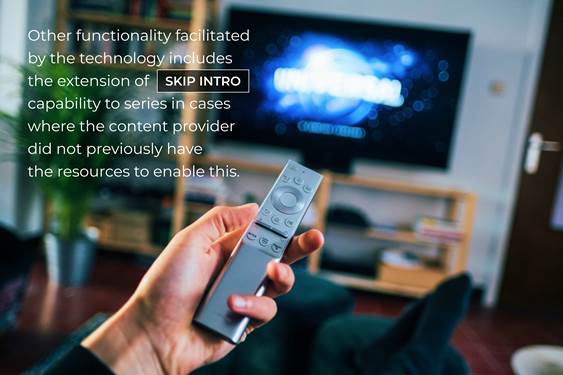
After more than 40 years of operation, DTVE is closing its doors and our website will no longer be updated daily. Thank you for all of your support.
The value of accuracy
 Video service providers have to absorb ever-growing storage costs to deliver services such as catch-up TV while also struggling to match the user experience of direct-to-consumer streamers. One technology vendor is addressing both problems with an innovative new technology.
Video service providers have to absorb ever-growing storage costs to deliver services such as catch-up TV while also struggling to match the user experience of direct-to-consumer streamers. One technology vendor is addressing both problems with an innovative new technology.
Video service providers and broadcasters are engaged in a competitive battle to be the gateway to customers’ entertainment at a time when the amount of content available to those customers is expanding seemingly without end.
For service providers acting in an increasingly app-based video world, functionality such as catch-up TV offer users the capabilities they value. Service providers faced with pressure on their existing revenue streams are also increasingly looking to make additional money from the content that passes through their hands by inserting advertising.
Optimising storage
These services come with a cost. Catch-up TV requires service providers or broadcasters to capture live TV as an on-demand asset and store it. To time their recordings they rely typically on EPG information that is not always accurate, meaning that they often waste huge amounts of storage capacity by recording material before and after the content required has started or finished.
For those seeking to make money from advanced advertising, another challenge is to insert ads into the relevant stream at the correct start and end points.
Given the inaccuracy of many EPGs in relation to start and end times of content, a technology that can solve the problem of matching recordings and advertising to relevant start and end times would surely be valuable. Enter StreamVX, a software-based technology outfit that has just launched an application — vxFinder — to solve some of these problems. vxFinder is one application that can be run from StreamVX’s overall platform, vxOS. Other functionalities include transcoding for video-on-demand to multiple endpoints. The system can run on existing video appliances or in the cloud.
In vxFinder the tech company has developed a technology that taps the power of artificial intelligence and machine learning to make recordings and advertising timings much more accurate, thus enabling service providers to comply with difficult rules set by platform operators and to save huge amounts of money on storage — as well as to provide an improved user experience to their end customers.
For Szymon Karbowski, CEO of StreamVX, the key application initially is to enable service providers to optimise their storage. This delivers an opportunity to make a clear and measure cost saving that also helps improve the user experience — a double win.
“Existing solutions are almost always based on the EPG timings, which means they’re not precise,” says Karbowski. “Our technology is capable of saying ‘this is the start time’, so you don’t have to rely on the EPG completely. We can use it either to adjust the EPG and instruct the recording to start at the proper time, or if you have a very large library of assets we can apply the process to that whole library.”
The few minutes saved for each unique recording can translate into a huge saving in recording costs over a large number of channels.
“vxFinder performs the function of a kind of safety switch to trim margins on recordings while keeping the actual content asset intact because the EPG is not accurate enough,” says Karbowski.
The ability to make recordings begin and end at the correct time, trimming non-essential content before and after, not only provides cost savings for the service provider but also improves the user experience — and this in a number of ways.
Not only does the technology give users the ability to access the content they want to watch immediately, it also frees the service provider to enable functionality such as fast-forward more smoothly in cases where ad-skipping is forbidden because the software can pinpoint exactly where an advert begins and ends.
 Other functionality facilitated by the technology includes the extension of ‘skip intro’ capability to series in cases where the content provider did not previously have the resources to enable this.
Other functionality facilitated by the technology includes the extension of ‘skip intro’ capability to series in cases where the content provider did not previously have the resources to enable this.
“You can pinpoint, in the player, the beginning and end of content, so you can generate a playlist in a way that the service provider can implement skip intro functionality for series that have previously been ingested into the on-demand library,” says Karbowski.
This is particularly useful in cases where content has been licensed for on-demand consumption but where the original owner has, for whatever reason, not passed on the proprietary metadata that could enable such functionality, or where metadata is incomplete or unavailable for some other reason.
The technology can therefore enable users to ‘skip the intro’ across a much wider range of content — an improvement to the user experience that provides an additional benefit to service providers. “This is now a natural utility for people and they complain about services that don’t have it,” says Karbowski, adding that “it’s not so easy to implement” and without a technology such as vxFinder would require human intervention to insert the correct markers.
vxFinder uses a mix of content recognition based on well-established markers and sophisticated AI to identify where content can be trimmed or adverts can be inserted in what Karbowski describes as a “hybrid approach”.
Karbowski says that the skip intro functionality that vxFinder enables is currently in trial with an operator in Poland.
Programmatic advertising
 While optimising storage costs and enabling features such as ‘skip intro’ are immediate applications that will excite service providers now, StreamVX’s technology could also have a significant role to play in enabling service providers to make money from streaming via programmatic advertising.
While optimising storage costs and enabling features such as ‘skip intro’ are immediate applications that will excite service providers now, StreamVX’s technology could also have a significant role to play in enabling service providers to make money from streaming via programmatic advertising.
“This is going to be the future because everybody has been speaking about programmatic advertising for a long time. Now we have most of the tools for this in place and we know it’s going to be good. It’s about being in the right place at the right moment,” says Karbowski.
vxFinder has an important potential role to play in enabling more sophisticated advertising models. It can provide an accurate count of the time allocated to advertising, which has an obvious application in regulatory compliance. It can also determine points for the accurate placement of SCTE35 signals to cue dynamic ad insertion.
vxFinder is currently in a number of trials in Poland and elsewhere in Europe. For pay TV operators the technology is valuable because it enables them to trim costs and deliver a superior user experience. While operators have access to content from their partners, it is, says Karbowski “not always being shared with the proper metadata”.
“So this is a good tool for them to remain competitive,” he says. “Operators are competing with the likes of Netflix, HBO and Discovery and the others but are also casting their content. They have to offer the customer the same functionality that the broadcaster or streamer is offering directly to the customer — that’s really the only way they can compete.”
This is sponsored content.

